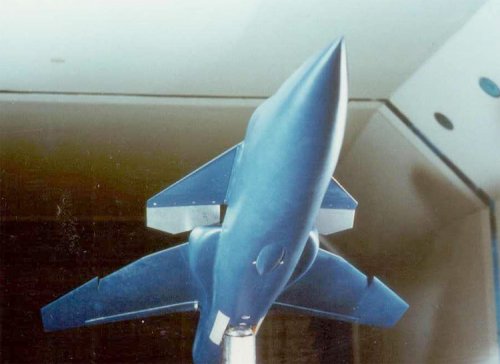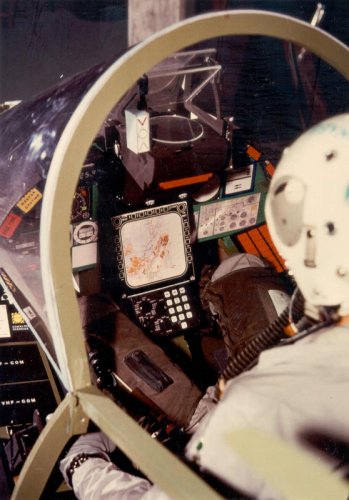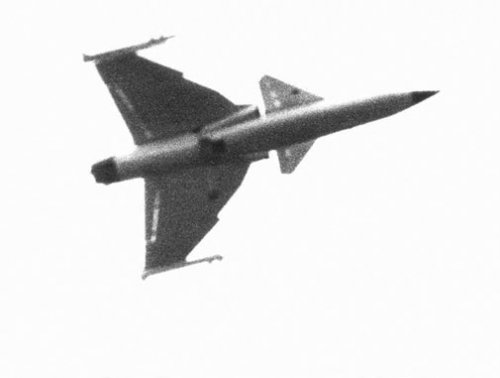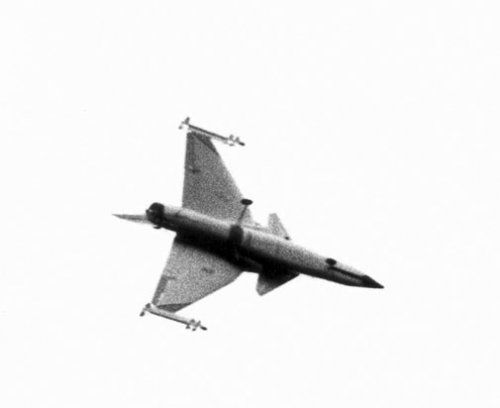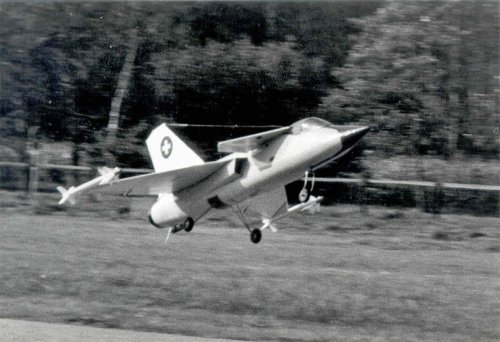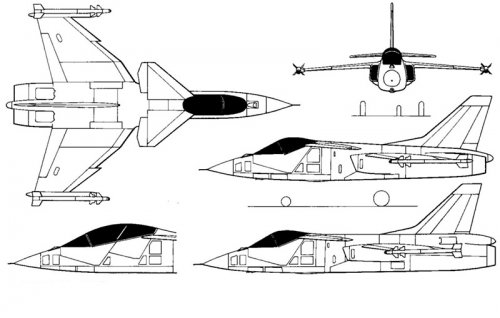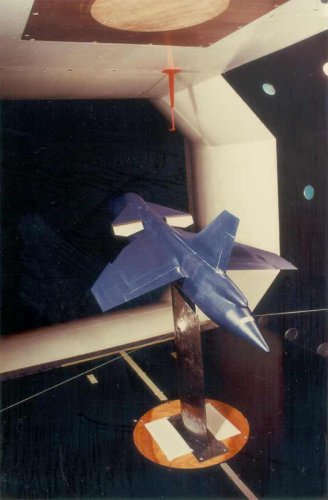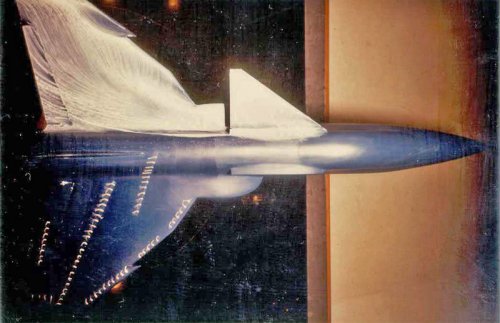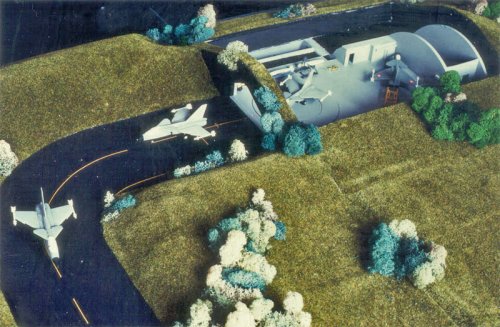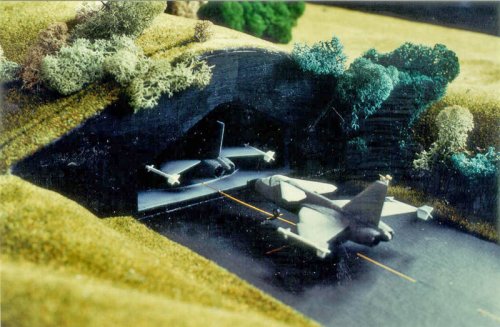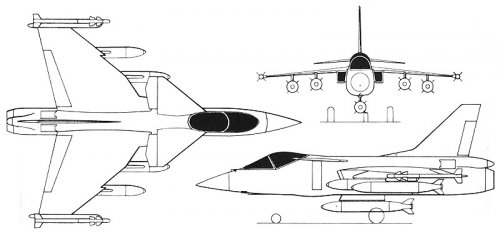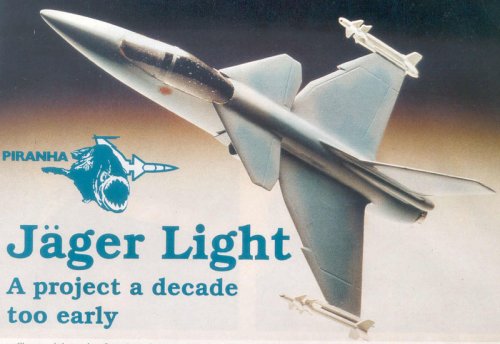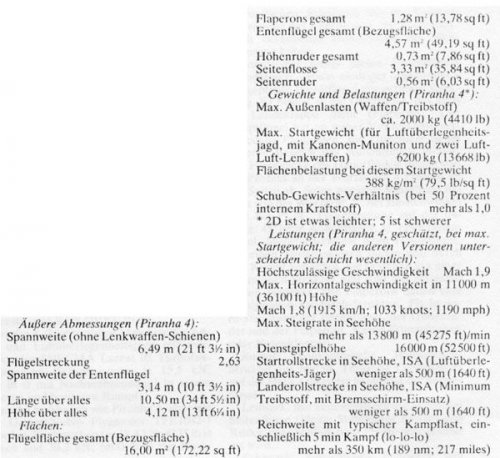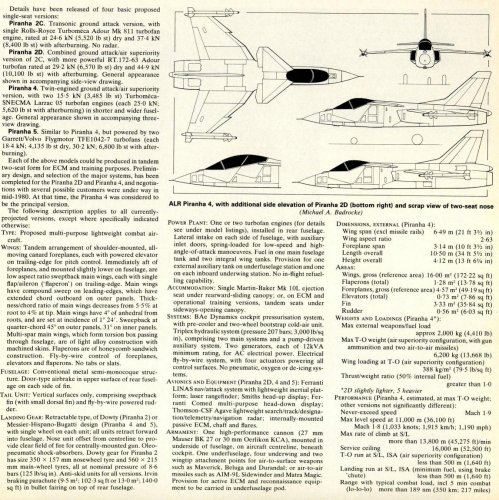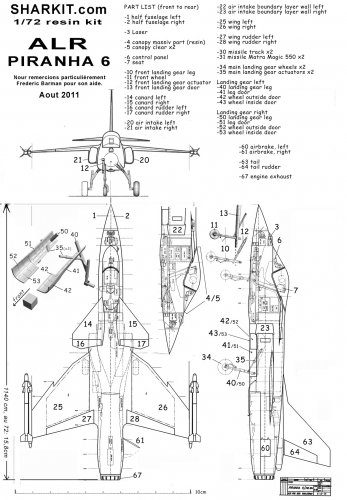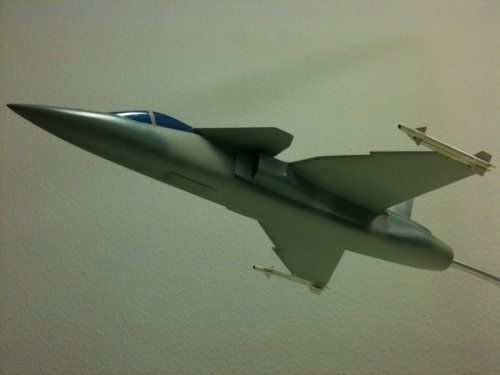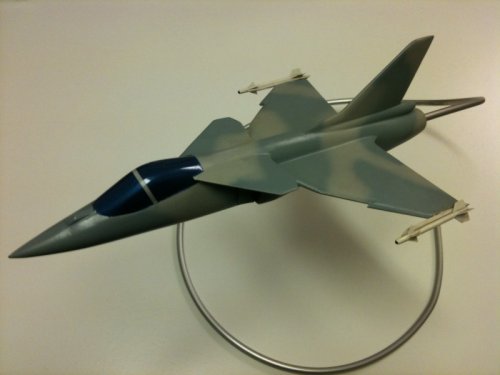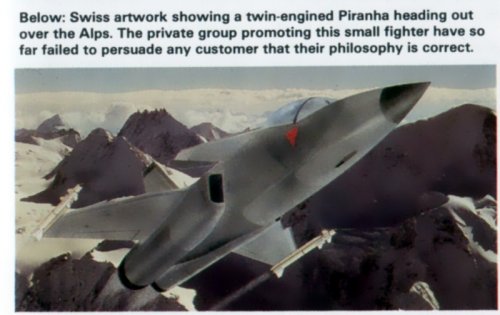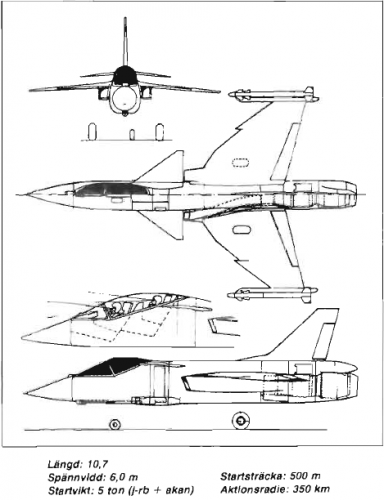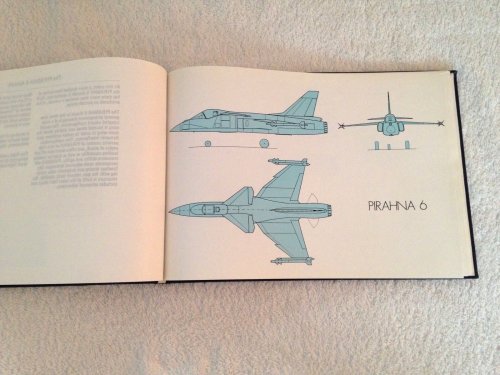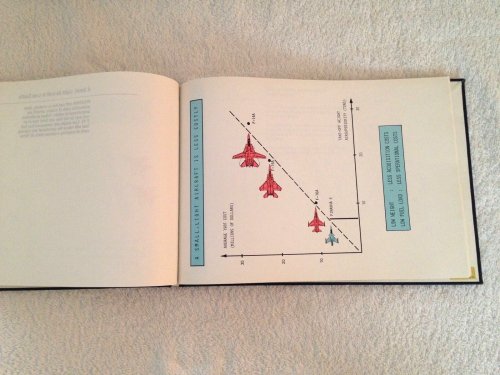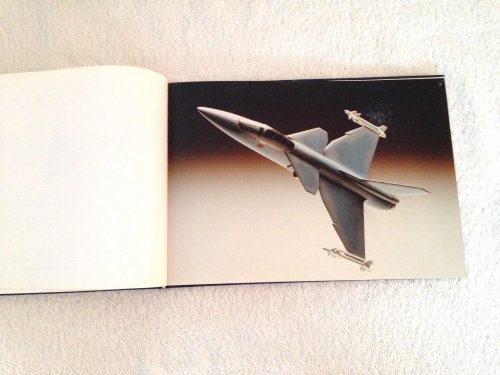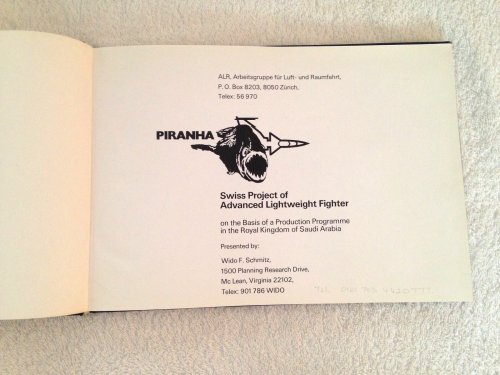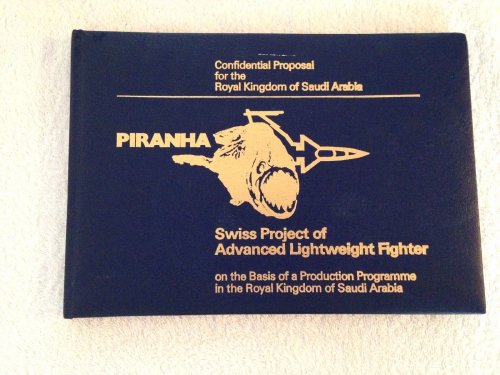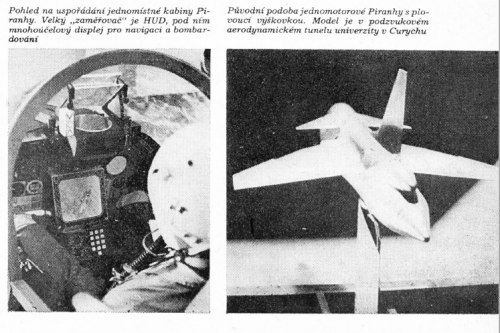PIRANHA
Young engineers, physicist, electronics engineer, military pilot and officers of maintenance and maintenance organization of the Swiss flight weapon completed the combat aircraft study Piranha in two-year joint venture work under the direction of Dr. Ing. Georges Bridel, Zurich.
With application of modern technology in design and equipment expect Piranha Vaeter "in relation to existing types substantially improved flight and weapon performances, which found their first confirmation by windkanalversuche and by flights with steered free flight model.
On the basis of the fact that the equipment of air forces with modern aircraft for small states becomes ever more problematic it resulted, the interesting and perhaps trailblazing project study Piranha. Current raising the price of of the flight material and its armament lets the fleet sizes together-shrink in such a manner that their efficiency in the combat mission becomes questionable.
As well known valuable aircraft - distributed on few bases - represent first-rate targets. So it might not fall a strong opponent too with difficulty to prevent the flying operation on these airfields by combined air raids and act of sabotage ions. Thereby it becomes however clear that the survival factor of a fleet with high-performance aircraft at the ground is crucial and that the question, whether the probability of survival in air reaches values around 0,95 or 0,97, can be neglected practically.
In addition it comes that combat tactics in the process of combat is adapted to conditions, against what the flexibility of the ground troops with their fixed systems - which airfield-own flier defense included - leaves only small possibilities open. The survival factor of an only small fleet at the ground depends in such a manner on the combat technique of the opponent that it can be approximately exactly predicted hardly.
A small fleet of high-performance aircraft might be sufficient therefore only in a situation, with which yet on enemy reactions to the own bases is not to be counted, thus for pure tasks of air police, which admits neutrality protection in Switzerland for example under the term is. In this case the mission achievment of the flight weapon of the calculation is rather accessible, because these are flown with support of a very efficient early warning and fighter control system.
A small fleet of high-performance aircraft might hardly be sufficient for the reasons mentioned therefore for a longer lasting conduct of operations. In contrast to it a larger fleet of light combat aircraft - to a large extent decentralized distributed on a larger number of airfields - would be in the position to lead the defense fight with the army longer time.
In addition it comes that the entire fleet is held at combat aircraft, including crews and equipment for maintenance and repair, under rock and concrete in readiness. Vulnerably are natural the launch and runways, the rolling races and the systems due to it outside of the covering, which must be placed by made available specialists of the airfield ground troops maintained and after destruction within useful period. It is with the fact obvious that only a to some extent homogeneous fleet can meet the requirements for the readiness of large a number of the existing combat aircraft as possible. That means: Type variety causes a too large expenditure for the training of the flying and ground personnel for supply, Munitionierung, maintenance and repair.
Concept for a new generation
The project authors see on the one hand an obligation to the standardization of the aircraft. On the other hand a new combat aircraft in as much as possible variants would have to be built. That means: The aircraft should be able to be used during continuous basic equipment for air and ground combat, reconnaissance, electronic warfare and application/mission training. The procurement of a type row would have to extend over longer periods, during which the grundtyp be improved and different variants can be introduced. The core of the problem lies then according to opinion of the project group in the question, which tasks these aircraft are to be transferred. These basic conditions refer to the need after a small light combat aircraft available in larger number, whereby without all-weather Interzeption and all-weather low attack (also from cost reasons) consciously is done. The project authors explain:
A small, light combat aircraft is generally cheaper than an aircraft with larger dimensions and weights.
New, high-quality weapons increase the value of the aircraft used in the fight; the disposable load can be reduced.
A small aircraft offers also in tactical regard large advantages.
Today's air and space technology make it possible to decrease or eliminate the disadvantages of former light fighters. New fan jets improve the range; the high conditions of the miniaturization technology reduce volume need and weight of the entire equipment.
When a theater regarded basis for the project Piranha, which is characterized by the application/mission of strong mechanized formations, which are protected by flier defense and fighter and supported by efficient ground combat aircraft. This view could be transferred in increasing dimension also to areas outside of Europe. The design of this new aerial engagement means would be limited therefore to the following ways of application:
Clear weather air defense,
Low-altitude flight attack in front proximity and behind the front, primarily with view conditions,
Reconnaissance and electronic conduct of operations and
Application/mission training.
All-weather capability would be actually desirable, means the members of the project group. It presupposes however efficient radar mechanisms and radar guided weapons, which are at present large and heavy (Sparrow Folgemuster) and already with central combat aircraft the flight performances through increased aerodynamic resistance considerably lowered. Same is valid to an efficient radar mechanism on board.
The concept of a clear weather combat aircraft for inferior to central flight altitudes justifies the tendency toward smaller dimensions and lower combat weight. To it equipment and combat procedures became parallel more simply and procurement costs for each combat unit lower. Further it is to be placed in calculation that attack methods for all-weather operation (target location with FLIR, thus no fast approach), which expose used flying formations straight by all-weather flier defense to increased endangerment, which would require again additional electronic counter measures. For the bulk of this fleet therefore visual flight attack methods would be sufficient, with which also the equipment catalog would be to be expected reduced and a work overloading of the crews not. An adequate use of Miliz pilots (for Swiss conditions) in air and ground combat would be ensured.
Now run out however the design for the double roll - air and ground combat - inevitably on a supersonic aircraft. This configuration favours the low-altitude flight in the transsonic flying range, which equals a crucial advantage regarding the threat by flier defense and fighter - an example for the fact that itself the requirements relative. Ground connection and aerial combat in substantial aspects would not contradict.
High-quality armament
A high-quality armament is to be aimed at in principle and be planned in the context of the possibilities of the modern weapon technology and improved flier defense.
For the aerial combat: High-performance gun, short-distance air-to-air guided weapons as well as medium range guided weapons for attacks from as large a angle divisions as possible.
For ground combat: High-performance gun, air-to-surface guided weapons, TV -, infrared or laser-guided weapons, cluster bombs, braked bombs and conventional bombs.
For reconnaissance and electronic combat measures a reduced active equipment can be taken into account.
Application/mission procedure
The safety mechanism of one locally and temporally it limited air superiority can only by as large a number of weapon beams in the combat area as possible be tried with which a saturation of the enemy air defense had to be achieved. The application/mission can take place from ground or air-steered radar stations out. The small dimensions of the aircraft decrease thereby the probability of discovery like also the chance with cannon bombardment to be met.
Abb. 3 shows a comparison of conventional low attacks with the attack methods with the application/mission with modern weapons. Likewise the effective ranges of some typical flier defensive weapons are represented. Modern bombs and the new high-performance gun KCA were used with very flat attack angles, whereby the aircraft flies through expanded neutral zones of flier defense. Air-to-surface guided weapons were partly used against it outside of the effective range of flier defense.
The disposable load with such weapons is on the one hand limited by the kleinheit of the carrier aircraft, on the other hand one carrying of a multiplicity of precision weapons is unwanted, because their launching presupposes a too long retention time in the target area, which is conceivable without application of extensive, most modern electronic means and only under the condition of an effective fighter protection. Both measures exceeded however smallnational possibilities by far.
Centre of gravity of all ground combat-in-corrodes must that surprisingly and extremely fast flown low attack be. Benefit the design of the light combat aircraft suitable for the aerial combat also the low attack, because supersonic aerodynamics necessary for the aerial combat as well as the engine power favoured the fast low-altitude flight.
The equipment of the projected light combat aircraft covers a navigation system which are based on passive sensors (e.g. LINAS von Ferranti), a bomb release system, a small air-to-air radar as well as an appropriate sight. When boundary condition for the use from decentralized bases STOL characteristics become required, thus runways can be used around 1000 m length, which is present in large number.
The system Piranha
The project authors placed themselves the task to examine a possible variant of the concept on his feasibility. Thus existing or systems in development were selected, in order to guarantee as realistic a conditions as possible. From several possible propulsion variants a solution on the basis of the engine roll Royce/Turbomeca Adour was aimed at. The design of the aircraft resulted from the synthesis of different requirements, which are given to others under, by short takeoff ability, good maneuverability, favorable weapon arrangement and appropriate accommodation of the engine and the various systems.
The project Piranha is characterized by the following outstanding features:
Also fully mobile canard wing and aileron landing flaps acre main wing combined shortcoupled canard configuration. The canard wing is set above the main wing level, from which favorable aerodynamic interference effects (polar one, laengsmoment) result.
Shoulder-wing monoplane arrangement, favorable accommodation of the external stores regarding aerodynamic interference effects (laengsmoment), free space for external stores (landing gear in the fuselage) and good accesibility for Munitionierung and maintenance.
Engine hanging inserted, whereby the free standing part of the cardan shaft housing can bear damages by IR guided weapon hits, without aircraft command is impaired.
Fly by wire control, whereby the operating cylinders come to lie completely in the fuselage and the wing by control assemblies would remain to a large extent free. The relatively simple flight control can be adapted by programming to the flying range optimally.
Central inserted high-performance gun 30 mm of Oerlikon, whose relatively high recoil force does not authorize a disturbing course moment (fig. 4). Rapidly replaceable ammunition container.
Application of conventional methods in the cellular construction.
Expandability: Artificial stability (CCV), application of composite materials.
In principle a light inertia system, laser rangefinder, small radar for target acquisition, zielfolge and ranging, head-up display system (or display system) and general-purpose display unit would cover navigation and attack system central in the cockpit, 360-Grad-Radarwarnempfaenger and a simple, active jammer. The intended system can be used in substantial parts both for air and for ground combat, so that neither into the one nor in the other roll much totes "weight would have to be built. Depending upon engine choice can be planned different types of the Piranha, so for instance an air and a ground-combat engagement version, a pure ground-combat engagement version as well as training and school versions.
The take-off weight is smaller for an equivalent mission, the dimensions is smaller than those the f-ë tiger II (20% smaller surface). The advantages of this small aircraft - higher probability of survival (smaller silhouette), good maintenance conditions in smaller shelters - are primarily also in the fact that the Piranha could profit from the increasing Miniaturierung the equipment at most.
In summary the features know this Projektswie follow to be emphasized:
Smaller procurement costs,
higher fleet sizes,
the entire application/mission aircraft can be distributed on more bases with allocation of the auxiliary bases, with which vulnerability at the ground became substantially smaller.
As a result of application of a small fan jet on small temperature level a weak IR characteristic would arise; thus increase of the chances of survival opposite IR guided weapons; smaller fuel consumption as well as reduction of the costs of training and training before transition to high-performance aircraft.
Text: Paul Kueng. Document reference: ALR (working group air and space travel, Zurich)

